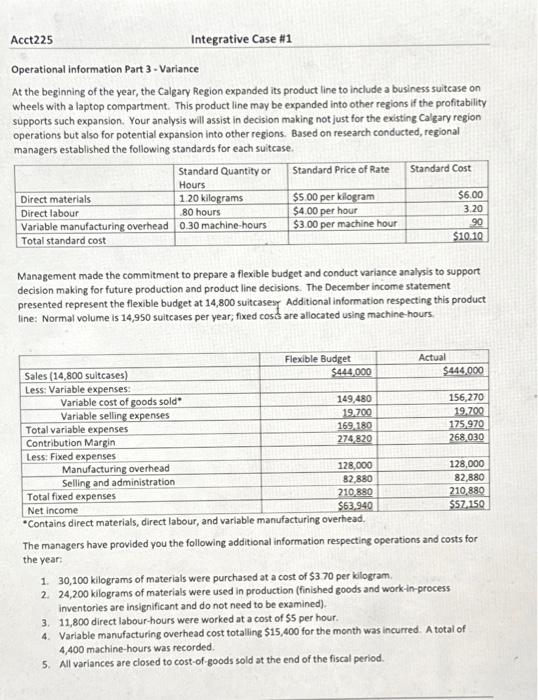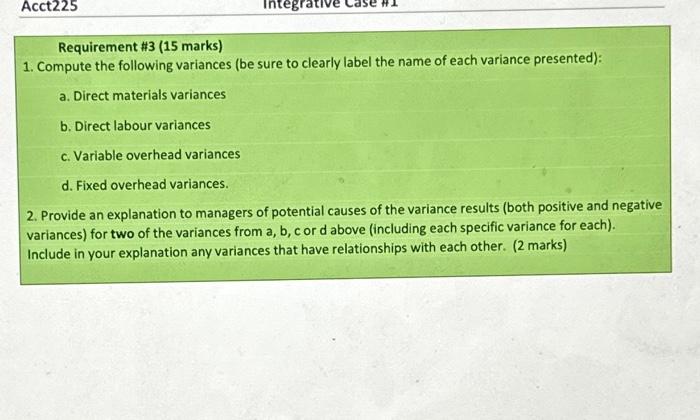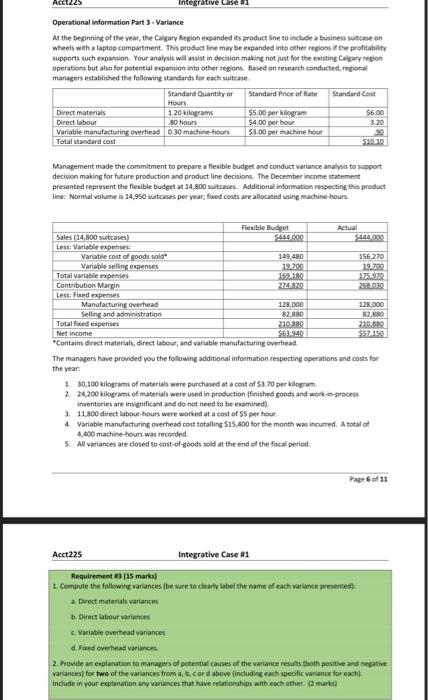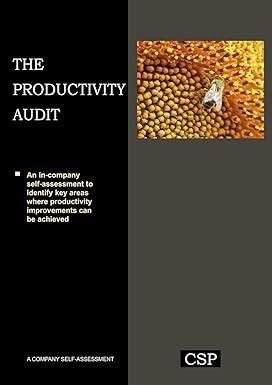Requirement \#3 (15 marks) 1. Compute the following variances (be sure to clearly label the name of each variance presented): a. Direct materials variances b. Direct labour variances c. Variable overhead variances d. Fixed overhead variances. 2. Provide an explanation to managers of potential causes of the variance results (both positive and negative variances) for two of the variances from a,b,c or d above (including each specific variance for each). Include in your explanation any variances that have relationships with each other. ( 2 marks) Operational information Part 3-Variance At the beginning of the year, the Calgary Region expanded its product line to include a business suitcase on wheels with a laptop compartment. This product line may be expanded into other regions if the profitability supports such expansion. Your analysis will assist in decision making not just for the existing Calgary region operations but also for potential expansion into other regions. Based on research conducted, regional managers established the following standards for each suitcase. Management made the commitment to prepare a flexible budget and conduct variance analysis to support decision making for future production and product line decisions. The December income statement presented represent the flexible budget at 14,800 suitcasey Additional information respecting this product line: Normal volume is 14,950 suitcases per year; fixed cosis are allocated using machine-hours. The managers have provided you the following additional information respecting operations and costs for the year: 1. 30,100 kilograms of materials were purchased at a cost of $370 per kilogram. 2. 24,200 kilograms of materials were used in production (finished goods and work-in-process inventories are insignificant and do not need to be examined). 3. 11,800 direct labour-hours were worked at a cost of $5 per hour. 4. Variable manufacturing overhead cost totalling $15,400 for the month was incurred. A total of 4,400 machine-hours was recorded. 5. All variances are closed to cost-of-goods sold at the end of the fiscal period. Operational information Part 3 -Variance An the beginning of the vear, the Calgary Region exsanded its product line to incluble a business suitcase on wheels with a laptop compartment. This product line mar be eapanded into other resions if the profitabilty supports such expanion. Your analysis will assist in decision makine not jast for the evistine Calcary refion operationt but also for potential expachion into other regions. fasied on reseacch conductes, regionat managers extabliched the follewing standards for each suitcase. Management made the commitment to prepare a fleuible budget and conduct variance analysa to support decision making for future production and product line decisions. The December income statement presented represent the flewible budget at 14,800 suitcases. Additional information respecting this product line: Normal vohume is 14,950 satcanes per year, fixed costs are allocated uning machine-hours. The managers have provided you the following additional information respecting operations and costs for the year: 1. 30,100 kilogram of materials were purchased at a coit af 3570 per kilogram. 2. 24,200 kilograms of muterials were used in production ffinished goods and work-in process. imventories are imvenificant and do net need to be examined). 3. 11.900 direct labout-hours were worked at a cost of $5 per hour. 4. Variable manufacturing overhead cost totalling $15,400 for the month was incurred. A total of 4,400 machine hours was recorded. 5. All variantes are cosed to cost-of-goods sold at the end of the fucal period. Acct225 Integrative Case a1 Requirement w [15 marks] 1. Compule the followine variances (be suce to clearly label the name of each varance presented). a. Derect materials variances 1. Direct Lbour variacees c. Variable overhead variances d. Fixed cremeas variancet. 2. Pruvide an euplanation to manapers of potential causes of the variance results fboth positve and negative varances) for two of the variances from a, b, c or d above (includire each specfic variance for each) Include in your explanation any variances that have relabionahips with each ocher. (2 maris)









